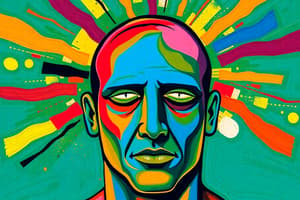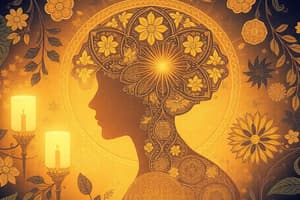Podcast
Questions and Answers
What is motivation?
What is motivation?
Motivation is when an organism experiences an inducement or incentive to do something.
Which of these is NOT a basic need in Maslow's Hierarchy of Needs?
Which of these is NOT a basic need in Maslow's Hierarchy of Needs?
- Safety and Security
- Financial Security (correct)
- Self-actualization
- Love and Belongings
Anorexia Nervosa is characterized by dramatic weight loss, a distorted body image, and resistance to eating enough to reach or maintain a healthful weight.
Anorexia Nervosa is characterized by dramatic weight loss, a distorted body image, and resistance to eating enough to reach or maintain a healthful weight.
True (A)
What is the basic emotion associated with a return to an unaroused state?
What is the basic emotion associated with a return to an unaroused state?
What is the term used for support provided by a parent or teacher to a child who is learning to perform a task?
What is the term used for support provided by a parent or teacher to a child who is learning to perform a task?
Which stage in Lawrence Kohlberg's model of moral development involves judging right and wrong based on conformity to conventional standards of right and wrong?
Which stage in Lawrence Kohlberg's model of moral development involves judging right and wrong based on conformity to conventional standards of right and wrong?
What is the name for the emotional tie that is formed between one animal or person and another specific individual?
What is the name for the emotional tie that is formed between one animal or person and another specific individual?
What is the type of parenting style that typically has strict guidelines about what is right and wrong and demands that children follow those guidelines?
What is the type of parenting style that typically has strict guidelines about what is right and wrong and demands that children follow those guidelines?
The empty nest syndrome is a sense of depression and loss of purpose felt by some parents when their youngest child leaves home.
The empty nest syndrome is a sense of depression and loss of purpose felt by some parents when their youngest child leaves home.
What is the term used to describe the reasonably stable patterns of emotions, motives, and behavior that distinguish one person from another?
What is the term used to describe the reasonably stable patterns of emotions, motives, and behavior that distinguish one person from another?
What is the term used to describe the defense mechanism that involves pushing threatening thoughts into the unconscious?
What is the term used to describe the defense mechanism that involves pushing threatening thoughts into the unconscious?
Alfred Adler’s Individual Psychology emphasizes feelings of inferiority and the creative self.
Alfred Adler’s Individual Psychology emphasizes feelings of inferiority and the creative self.
What is the term used to describe the store of vague memories that represent the history of humankind according to Carl Jung?
What is the term used to describe the store of vague memories that represent the history of humankind according to Carl Jung?
What is the term used to describe a persistent expression of esteem for the value of a person, but not necessarily unqualified acceptance of all the person's behaviors?
What is the term used to describe a persistent expression of esteem for the value of a person, but not necessarily unqualified acceptance of all the person's behaviors?
Existentialism emphasizes personal freedom, responsibility, and finding meaning in life.
Existentialism emphasizes personal freedom, responsibility, and finding meaning in life.
Eysenck’s model of personality includes the dimensions of Introversion-Extraversion, Stable-Unstable, and Psychoticism.
Eysenck’s model of personality includes the dimensions of Introversion-Extraversion, Stable-Unstable, and Psychoticism.
What is the term used for the tendency to inhibit impulses according to McCrae and Costa’s Big Five model of personality?
What is the term used for the tendency to inhibit impulses according to McCrae and Costa’s Big Five model of personality?
The Big Five model of personality includes the following dimensions: Openness to Experience, Conscientiousness, Extraversion, Agreeableness, and Neuroticism.
The Big Five model of personality includes the following dimensions: Openness to Experience, Conscientiousness, Extraversion, Agreeableness, and Neuroticism.
What is the term used to describe behaviors or mental processes that are connected in various kinds of distress, significant impairment and functioning, however they are not predictable to various events?
What is the term used to describe behaviors or mental processes that are connected in various kinds of distress, significant impairment and functioning, however they are not predictable to various events?
What is the term used for a model that explains psychological disorders in terms of a combination of biological vulnerabilities, psychological factors such as exposure to stress, and sociocultural factors such as family relationships and cultural beliefs?
What is the term used for a model that explains psychological disorders in terms of a combination of biological vulnerabilities, psychological factors such as exposure to stress, and sociocultural factors such as family relationships and cultural beliefs?
Generalized anxiety disorder is characterized by persistent anxiety that cannot be attributed to a phobic object, situation, or activity.
Generalized anxiety disorder is characterized by persistent anxiety that cannot be attributed to a phobic object, situation, or activity.
What is the term used to describe the repetitive thoughts (obsessions) and behaviors (compulsions) that characterize obsessive-compulsive disorder?
What is the term used to describe the repetitive thoughts (obsessions) and behaviors (compulsions) that characterize obsessive-compulsive disorder?
What is the type of disorder characterized by trauma as in threat to life or sexual assault?
What is the type of disorder characterized by trauma as in threat to life or sexual assault?
Dissociative disorders are characterized by disruptions in memory or identity.
Dissociative disorders are characterized by disruptions in memory or identity.
What is the term used for the experience of feeling detached from themselves or feeling that the world around them is unreal?
What is the term used for the experience of feeling detached from themselves or feeling that the world around them is unreal?
Somatic symptom and related disorders are characterized by physical symptoms that cannot be explained by a medical condition.
Somatic symptom and related disorders are characterized by physical symptoms that cannot be explained by a medical condition.
What is the term used to describe disturbances in emotional states?
What is the term used to describe disturbances in emotional states?
Bipolar disorder is characterized by alternating periods of depression and mania.
Bipolar disorder is characterized by alternating periods of depression and mania.
Schizophrenia is characterized by positive and negative symptoms, which include hallucinations, delusions, disorganized thinking, and inappropriate behavior.
Schizophrenia is characterized by positive and negative symptoms, which include hallucinations, delusions, disorganized thinking, and inappropriate behavior.
Flashcards
Intrinsic Motivation
Intrinsic Motivation
Motivation driven by internal satisfaction.
Extrinsic Motivation
Extrinsic Motivation
Motivation driven by external rewards.
Maslow's Hierarchy
Maslow's Hierarchy
A ranked list of needs, from basic to complex.
Self-Actualization
Self-Actualization
Signup and view all the flashcards
Leptin
Leptin
Signup and view all the flashcards
Ghrelin
Ghrelin
Signup and view all the flashcards
Anorexia Nervosa
Anorexia Nervosa
Signup and view all the flashcards
Bulimia Nervosa
Bulimia Nervosa
Signup and view all the flashcards
Sexual Response Cycle
Sexual Response Cycle
Signup and view all the flashcards
Zygote
Zygote
Signup and view all the flashcards
Amniotic Sac
Amniotic Sac
Signup and view all the flashcards
Placenta
Placenta
Signup and view all the flashcards
Umbilical Cord
Umbilical Cord
Signup and view all the flashcards
Reflex
Reflex
Signup and view all the flashcards
Rooting
Rooting
Signup and view all the flashcards
Sensorimotor Stage
Sensorimotor Stage
Signup and view all the flashcards
Assimilation
Assimilation
Signup and view all the flashcards
Schema
Schema
Signup and view all the flashcards
Accommodation
Accommodation
Signup and view all the flashcards
Zone of Proximal Development
Zone of Proximal Development
Signup and view all the flashcards
Scaffolding
Scaffolding
Signup and view all the flashcards
Secure Attachment
Secure Attachment
Signup and view all the flashcards
Avoidant Attachment
Avoidant Attachment
Signup and view all the flashcards
Ambivalent/Resistant Attachment
Ambivalent/Resistant Attachment
Signup and view all the flashcards
Study Notes
Motivation and Emotion
- Motivation is an organism's inducement to act
- Intrinsic motivation is driven by internal satisfaction
- Extrinsic motivation is driven by external rewards
- Maslow's Hierarchy of Needs prioritizes needs from basic (physiological) to complex (self-actualization)
- Physiological Needs: hunger, thirst
- Safety and Security: shelter, protection
- Love and Belongings: connection, intimacy
- Esteem Needs: self-worth, respect
- Self-Actualization: achieving one's full potential
- Hormones influence appetite (e.g., leptin suppresses, ghrelin increases)
- Eating disorders include anorexia nervosa (extreme fear of weight gain) and bulimia nervosa (bingeing and purging)
- Sexual Response Cycle includes arousal, plateau, orgasm, and resolution
- Basic emotions: happy, sad, angry, fear, disgust, surprise
Life Span and Development
- Prenatal development includes the zygote, amniotic sac, and placenta
- The umbilical cord connects the fetus to the mother
- Infancy and toddlerhood involves reflexes and motor skills
- Milestones include rooting, fixation time, and sensorimotor stages
- Erikson's stages of psychosocial development (e.g., Trust vs. Mistrust, Autonomy vs. Shame & Doubt)
- Childhood involves cognitive development stages (preoperational, concrete operational, formal operational) and psychosocial stages
- Adolescence and puberty involves identity formation (Erikson)
- Adulthood involves intimacy, generativity, and integrity (Erikson)
- Death and dying process
Cognitive Development
- Piaget's theory details cognitive stages (sensorimotor, preoperational, concrete operational, formal operational) with associated schemas and adaptations
- Vygotsky emphasizes the zone of proximal development and scaffolding in learning
- Kohlberg focuses on moral development stages (preconventional, conventional, postconventional)
Moral Development
- Kohlberg's theory of moral development outlines stages of moral reasoning
- Preconventional level: consequences determine morality
- Conventional level: social norms govern morality
- Postconventional level: ethical principles guide morality.
Psychosocial Development
- Erikson's stages of psychosocial development address the challenges of each life stage.
- Examples include trust vs. mistrust, autonomy vs. shame and doubt, initiative vs. guilt, and industry vs. inferiority, identity vs. role confusion, intimacy vs. isolation, generativity vs. stagnation, and integrity vs. despair.
Attachment
- Attachment is an emotional bond between individuals
- Attachment theory focuses on patterns of attachment during infancy and their impact on development
- Attachment styles are categorized as secure, anxious-avoidant, and anxious-resistant
Personality
- Various theories explain personality, including psychodynamic (Freud, Adler, Jung, Horney), humanistic (Rogers, Maslow), trait (Eysenck, McCrae & Costa), behavioral and sociocultural
- Freud emphasizes the unconscious mind, defense mechanisms, and psychosexual stages
- Adler focuses on social interest and the inferiority complex
- Jung introduces the collective unconscious and archetypes
- Horney highlights the role of social relationships in personality development
- Rogers focuses on self-actualization and unconditional positive regard
- Maslow's hierarchy of needs explains motivation from a humanistic perspective
- Eysenck's theory categorizes personality traits
- The Big Five personality traits (Openness, Conscientiousness, Extraversion, Agreeableness, Neuroticism) are extensively researched traits.
Psychological Disorders
- Psychological disorders are diagnosed through the DSM.
- Symptoms include anxiety, mood swings, and delusions.
- Disorders include phobias (specific, social, agoraphobia), generalised Anxiety disorder, panic disorder, obsessive-compulsive disorder, and depressive disorders, bipolar disorder, schizophrenia
- Treatment modalities like medication and therapy are discussed
Stress, Health, and Coping
- Stressors are demands to adapt, cope, or adjust
- Health psychology examines relationships between psychological factors and physical health
- Factors include hassles, life changes, eustress, and distress
- Psychological moderators of stress include self-efficacy, sense of humor, and psychological hardiness
Studying That Suits You
Use AI to generate personalized quizzes and flashcards to suit your learning preferences.




